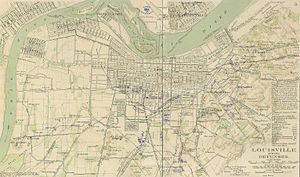American Civil War fortifications in Louisville facts for kids
Louisville's Civil War Forts were built to protect Louisville, Kentucky. During the American Civil War, Louisville was a very important place. It served as a major supply center for the Union army. This meant many supplies for the war effort passed through the city.
The idea to build these forts came in October 1862. This was after a big Confederate attack in Kentucky, which stopped at the Battle of Perryville. Building the forts started in 1863. Work was slow at first. But in late 1864, Confederate forces moved towards Nashville, Tennessee. This made General Hugh Ewing ask the city for help. He wanted people to help build the forts faster.
Since many military engineers were fighting, regular engineers designed Louisville's forts. The forts were named after Union officers who had died in battle. Even though the forts were ready, Louisville was never directly attacked. So, the cannons in the forts were never fired in battle. They were only used for special salutes.
What the Forts Were Like
These forts were different from older ones. They were made to stand up to heavy cannon fire. Earlier forts were often built quickly from stone and wood. It was decided that a five-mile (8 km) protection zone was not enough. So, the new forts were built further out. They did not use any existing old forts.
Each fort usually had at least 50 artillerists (cannon operators). They also had 200 infantrymen (foot soldiers). Each fort was armed with four to six cannons. There were eleven forts and twelve smaller batteries. They formed a 10.5-mile (17 km) arc around the city. The Ohio River protected the city's northern side.
The forts were placed on high ground. This allowed them to shoot at enemy forces from different angles. The forts were about 550 to 700 feet (168 to 213 meters) long. Their walls were very thick, from fifteen to thirty feet (4.5 to 9 meters). The walls were also six to eight feet (1.8 to 2.4 meters) high. Each gun in the forts had 200 rounds of ammunition ready.
The Forts
Here are the names of the forts and a little about them:
- Fort Clark: This fort was at 36th and Magnolia Streets. It was named for Lt. Col. Merwin Clark. He was from the 183rd Ohio Infantry and died in November 1864.
- Fort Elster: This fort was near Beargrass Creek, where it meets the Ohio River. It was named for Lt. Col. George R. Elstner. He was from the 50th Ohio Infantry and died in August 1864.
- Fort Engle: You could find this fort at Arlington Avenue and Spring Street. It was named for Captain Archibald H. Engle. He was from the 13th U.S. Infantry and died in May 1864.
- Fort Hill: This fort was on a hill near St. Louis Cemetery. It was named for Captain George W. Hill. He was from the 12th Kentucky Infantry and died in August 1864.
- Fort Horton: This fort was where Merriwether and Shelby Streets meet. It was named for Captain M.C. Horton. He was from the 104th Ohio Infantry and died in May 1864.
- Fort Karnash: This fort was between 26th and 28th Streets on Wilson Avenue. It was named for Second Lieutenant Julius E. Karnash. He was from the 35th Missouri Infantry and died in August 1864.
- Fort McPherson: This was the largest of Louisville's forts. It was near Preston Street and the old Shepherdsville Turnpike. It was named for Major General James B. McPherson. He died in July 1864. This fort could hold up to a thousand soldiers. It had a special Parrott rifle cannon. This cannon could shoot a 100-pound shell five miles (8 km) away. It also had ten other cannons.
- Fort Philpot: This fort was by Algonquin Parkway and what is now Seventh Street Road. It was named for Captain J. D. Philpot. He was from the 103rd Ohio Infantry and died in May 1864.
- Fort Saint Clair Morton: This fort was on a small hill near where 16th and Hill Streets would meet. It guarded what is now Dixie Highway. It was named for Major James St. Clair Morton. He was an engineer who died in June 1864.
- Fort Saunders: This fort was inside Cave Hill Cemetery. It was named for E.D. Saunders. He died in June 1864.
- Fort Southworth: This fort was on Paddy's Run, near the Ohio River. It was the westernmost fort. It covered about 19,000 square feet (1,765 square meters). It was named for A. J. Southworth, who died in August 1864. Building started on August 1, 1864. Both Louisville and the government paid for it.
The Batteries
Only two of the planned twelve smaller batteries were built:
- Battery Camp: This battery was between Fort Hill and Fort Saunders. It was at Baxter and Rufer Avenue. It was named for Captain Edgar Camp. He was from the 107th Illinois Infantry and died in battle.
- Battery Gallup: This battery was between Fort Clark and Fort Southworth. It was on part of the old State Fairgrounds. It was named for A.G. Gallup. He was from the 13th Kentucky Infantry and died in September 1864.
After the War
By March 31, 1865, most of the eleven forts were finished. On May 1, building stopped. This was because most Confederate forces had already given up. The forts were supposed to have between 44 and 66 cannons. But only 22 were installed when construction stopped.
None of these forts built to protect Louisville have survived today.



